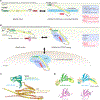WASP family proteins: Molecular mechanisms and implications in human disease
- PMID: 35667337
- PMCID: PMC9357188
- DOI: 10.1016/j.ejcb.2022.151244
WASP family proteins: Molecular mechanisms and implications in human disease
Erratum in
-
Corrigendum to "WASP Family Proteins: Molecular Mechanisms and Implications in Human Disease" [Eur. J. Cell Biol. Vol. 101, Issue 3, (2022) 151244].Eur J Cell Biol. 2023 Mar;102(1):151287. doi: 10.1016/j.ejcb.2023.151287. Epub 2023 Jan 11. Eur J Cell Biol. 2023. PMID: 36635185 No abstract available.
Abstract
Proteins of the Wiskott-Aldrich syndrome protein (WASP) family play a central role in regulating actin cytoskeletal dynamics in a wide range of cellular processes. Genetic mutations or misregulation of these proteins are tightly associated with many diseases. The WASP-family proteins act by transmitting various upstream signals to their conserved WH2-Central-Acidic (WCA) peptide sequence at the C-terminus, which in turn binds to the Arp2/3 complex to stimulate the formation of branched actin networks at membranes. Despite this common feature, the regulatory mechanisms and cellular functions of distinct WASP-family proteins are very different. Here, we summarize and clarify our current understanding of WASP-family proteins and how disruption of their functions is related to human disease.
Keywords: Actin; Arp2/3; Cyfip; HEM; JMY; SCAR; SHRC; SWIP; Sra1; Strumpellin; VCA; WASH; WASP; WAVE; WCA; WHAMM; WHIMP; WRC; Wiskott-Aldrich syndrome.
Copyright © 2022 The Authors. Published by Elsevier GmbH.. All rights reserved.
Figures





Similar articles
-
WAVE regulatory complex.Curr Biol. 2021 May 24;31(10):R512-R517. doi: 10.1016/j.cub.2021.01.086. Curr Biol. 2021. PMID: 34033782 Free PMC article.
-
Branching out in different directions: Emerging cellular functions for the Arp2/3 complex and WASP-family actin nucleation factors.Eur J Cell Biol. 2023 Jun;102(2):151301. doi: 10.1016/j.ejcb.2023.151301. Epub 2023 Mar 2. Eur J Cell Biol. 2023. PMID: 36907023 Free PMC article.
-
Scar/WAVE drives actin protrusions independently of its VCA domain using proline-rich domains.Curr Biol. 2024 Oct 7;34(19):4436-4451.e9. doi: 10.1016/j.cub.2024.08.013. Epub 2024 Sep 26. Curr Biol. 2024. PMID: 39332399
-
Under lock and key: spatiotemporal regulation of WASP family proteins coordinates separate dynamic cellular processes.Semin Cell Dev Biol. 2013 Apr;24(4):258-66. doi: 10.1016/j.semcdb.2012.12.005. Epub 2013 Jan 3. Semin Cell Dev Biol. 2013. PMID: 23291261 Free PMC article. Review.
-
New insights into the regulation and cellular functions of the ARP2/3 complex.Nat Rev Mol Cell Biol. 2013 Jan;14(1):7-12. doi: 10.1038/nrm3492. Epub 2012 Dec 5. Nat Rev Mol Cell Biol. 2013. PMID: 23212475 Review.
Cited by
-
Formation of Membrane Domains via Actin Waves: A Fundamental Principle in the Generation of Dynamic Structures in Phagocytes.Int J Mol Sci. 2025 May 16;26(10):4759. doi: 10.3390/ijms26104759. Int J Mol Sci. 2025. PMID: 40429901 Free PMC article. Review.
-
F-actin-rich territories coordinate apoptosome assembly and caspase activation during DNA damage-induced intrinsic apoptosis.Mol Biol Cell. 2023 May 1;34(5):ar41. doi: 10.1091/mbc.E22-04-0119. Epub 2023 Mar 15. Mol Biol Cell. 2023. PMID: 36920061 Free PMC article.
-
Scar/WAVE has Rac GTPase-independent functions during cell wound repair.Sci Rep. 2023 Mar 23;13(1):4763. doi: 10.1038/s41598-023-31973-2. Sci Rep. 2023. PMID: 36959278 Free PMC article.
-
Structures reveal a key mechanism of WAVE regulatory complex activation by Rac1 GTPase.Nat Commun. 2022 Sep 16;13(1):5444. doi: 10.1038/s41467-022-33174-3. Nat Commun. 2022. PMID: 36114192 Free PMC article.
-
Myosin-I synergizes with Arp2/3 complex to enhance the pushing forces of branched actin networks.Sci Adv. 2024 Sep 13;10(37):eado5788. doi: 10.1126/sciadv.ado5788. Epub 2024 Sep 13. Sci Adv. 2024. PMID: 39270022 Free PMC article.
References
-
- Alkhairy OK, Rezaei N, Graham RR, Abolhassani H, Borte S, Hultenby K, Wu C, Aghamohammadi A, Williams DA, Behrens TW, Hammarström L, Pan-Hammarström Q, 2015. RAC2 loss-of-function mutation in 2 siblings with characteristics of common variable immunodeficiency. J. Allergy Clin. Immunol 135, 1380–1384.e5. 10.1016/j.jaci.2014.10.039 - DOI - PMC - PubMed
MeSH terms
Substances
Grants and funding
LinkOut - more resources
Full Text Sources
Research Materials

